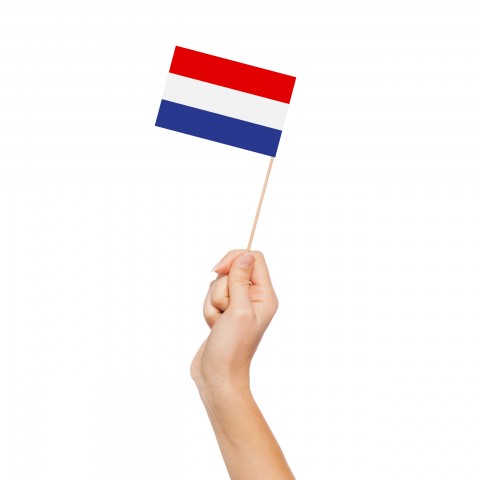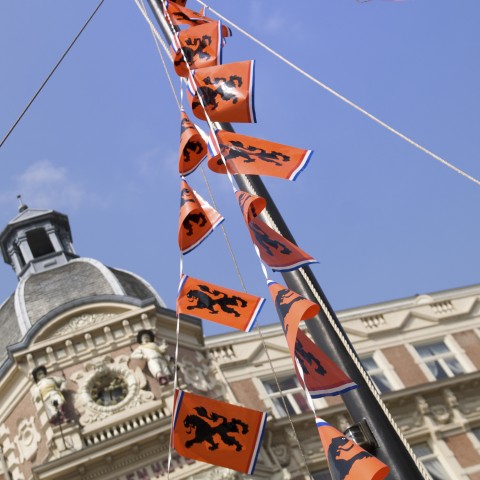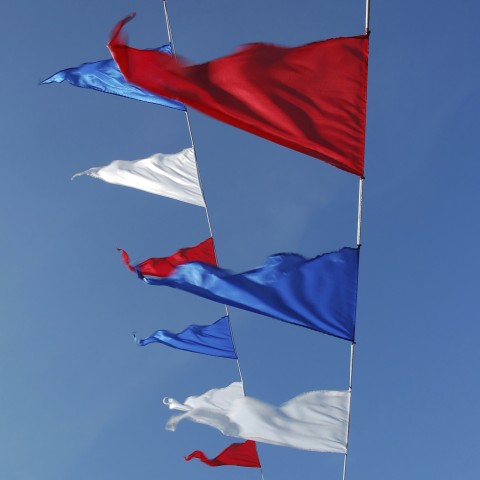
Have you ever heard Het Wilhelmus, the Dutch national anthem? It’s one of the oldest anthems in existence, and therefore the lyrics are not always easy to understand, full of old-fashioned words and unusual turns of phrases. It’s an anthem of fifteen verses, but mainly the first (and sometimes also the sixth) verse is sung. However, because of the old nature of the Dutch anthem, not all Dutch know the words or understand the meaning. Why is the Spanish king mentioned in the Dutch national anthem? And what about that mention of German blood?
As you can see, the Dutch anthem is not free of controversy, and some people even say that it should be changed. However, although the Dutch don’t sing their national anthem very often, when they sing it on special occasions, everybody will sing along, even those that don’t know all the words, as you can always mumble or hum along.
In this article, we will first show you the history of the Dutch national anthem. We’ll then talk about its lyrics, the meaning of the Dutch anthem, and the criticisms it has received.

 Table of Contents
Table of Contents
- The History
- Explaining the Lyrics of Het Wilhelmus
- When is it Played?
- Should the Netherlands Find a New National Anthem?
- How DutchPod101 Can Help You Learn More Dutch
1. The History
Before we have a look at the lyrics of the Dutch national anthem, it might come in handy to first learn more about its history. This way you will be able to understand better what it’s all about.
So, the Dutch national anthem is actually one of the world’s oldest patriotic songs, as it dates back to at least 1572. The lyrics were written at the beginning of the Eighty Years’ War (1568-1648), also known as The Dutch War of Independence. The Dutch anthem, therefore, tells the story of Willem van Oranje (“William of Orange”) and his fight against the King of Spain in order to gain independence for the Netherlands. The anthem is written from William’s perspective and follows his struggle to remain loyal to the Spanish king, who he has always served, while also serving God and leading his people in the fight against persecution.
But who is Willem van Oranje? He is also known as Willem van Nassau, or in old Dutch Wilhelmus van Nassouwe, which explains the title of the Dutch anthem. He was one of the main leaders of the Dutch revolt against the Spanish that set off the Eighty Years’ War and resulted in the formal independence of what now is known as (part of) the Netherlands. He is, therefore, also known as Vader des Vaderlands (“Father of the Fatherlands”). Besides this, he is also the founder of the Orange-Nassau royal family, which makes him the ancestor of the Dutch monarchy.
It took some time before Het Wilhelmus officially became the Dutch national anthem. At the beginning of the 19th century, the song was mainly sung by supporters of the Dutch royal family. However, they were not particularly popular during this period. So, when Het Wilhelmus became the official Dutch national anthem in 1932, there were protests.
But what changed in the following years? During the Nazi occupation of the Second World War, the Dutch national anthem regained popularity. This song of victory served as a way to express Dutch national pride and solidarity.
2. Explaining the Lyrics of Het Wilhelmus
So, as you now know the history of the Netherlands’ national anthem, it’s time to have a look at the lyrics of Het Wilhelmus.
1- The Lyrics
- ➜ Do you have difficulties understanding Dutch? Let’s have a look at these useful tips on How to Improve Your Listening Skills.
The Dutch anthem has an impressive fifteen verses; the first letter of all verses originally formed the word Willem van Nassov, another old Dutch way to say Willem van Nassau. However, the Dutch only sing one or two verses of the anthem. It’s mainly the first verse that is sung, sometimes followed by the sixth verse.
Also you may notice, even in the contemporary Dutch version, some of the words have been changed so that they fit the rhythm or so they rhyme. So, don’t worry if you can’t always figure out some of the words.
Verse 1
| Old Dutch | Contemporary Dutch | Translation |
| Wilhelmus van Nassouwe Ben ick van Duytschen Bloedt, Den Vaderland ghetrouwe Blijf ick tot inden doet; Een Prince van Orangien Ben ick vry onverveert. Den Coninck van Hispangien. Heb ick altijt gheeert. | Wilhelmus van Nassouwe Ben ik van Duitsen bloed Den vaderland getrouwe Blijf ik tot in den dood. Een Prinse van Oranje Ben ik, vrij onverveerd. Den Koning van Hispanje Heb ik altijd geëerd. | “William of Nassau, Am I of German descent True to the fatherland I remain until death. Prince of Orange Am I, free and fearless To the King of Spain I have always given honor.” |
Verse 6
| Old Dutch | Contemporary Dutch | Translation |
| Mijn schilt ende betrouwen Zijt ghy, O Godt, mijn Heer. Op U soo wil ick bouwen, Verlaet my nimmermeer; Dat ick doch vroom mag blijven U dienaer t’aller stondDie tyranny verdrijven, Die my mijn hert doorwondt. | Mijn schild ende betrouwen Zijt Gij, o God mijn Heer. Op U zo wil ik bouwen, Verlaat mij nimmermeer; Dat ik doch vroom mag blijven, Uw dienaar t’aller stond. De tirannie verdrijven, Die mij mijn hart doorwondt. | “You, my God and Lord, Are my shield, on You I rely. On You I will build, Never leave me; So that I may remain pious, Your servant at all moments. Dispelling the tyranny. That wounds my heart.” |
2- Why Does the Dutch Anthem Mention Duitsen bloed?
It may have surprised you to read that the Dutch national anthem mentions Duitsen bloed in the first verse. This means “German blood” or “German descent”. And many Dutch also interpret it this way. However, Germany did not exist yet during Willem van Oranje’s life. Some say that it therefore does not refer to Germany but the lowlands area that includes what we now know as the Netherlands and certain areas of Germany, where William of Orange was also born.
3. When is it Played?
The Dutch in general aren’t the most nationalistic people out there. However, there are some occasions when they let their national pride flow. And this is often also the moment where Het Wilhelmus is played.
It’s probably most likely that you hear the Dutch national anthem during international sporting events, such as the European or World Cup football tournaments. Another popular event is the Olympic Games, where the Dutch anthem is played when a Dutch sportsman- or woman wins an Olympic gold medal. So especially during the Winter Olympics you might be able to enjoy the Dutch national anthem a few times.
- ➜ Do you want to celebrate the Olympic Games with the Dutch? Be sure to check out our useful vocabulary lists on the Summer and Winter Olympics.
Furthermore, there are some rare national moments when the Dutch also sing their anthem. And they all happen to take place around the same period: Koningsdag (“King’s day”) on the 27th of april, Dodenherdenking (“National Remembrance Day”), on the 4th of May, and Bevrijdingsdag (“Liberation Day”) on the 5th of May.
- ➜ Would you like to know how to talk in Dutch about these special national days? Have a look at our Liberation Day, National Remembrance Day and King’s Day vocabulary lists with useful audio recordings to practice your pronunciation.

Finally, another moment when the Dutch anthem is played is when the Netherlands hosts a foreign head of state.
4. Should the Netherlands Find a New National Anthem?
As you might already have guessed, the Dutch national anthem is not free of controversy. German blood, the King of Spain and dispelling tyranny: Het Wilhelmus is more of a historical text than a contemporary national anthem.
Some attempts to modernize the Dutch anthem have been made, for example by a former lady-in-waiting of Queen Beatrix:
Wilhelmus van Nassouwe,
De Vader van ons land
Symbool van het vertrouwen,
in onze vaste band.
Met allen die hier leven,
In vrijheid en in recht
Moog dat ons voor altijd zijn gegeven,
zoals ons is toegezegd.
(“William of Nassouwe,
The Father of our country
Symbol of confidence,
in our firm bond.
With all who live here,
In freedom and in justice
May we be given that forever,
as promised to us.”)
However, this nor any other attempts have been successful. Many still see the Dutch anthem as cultural heritage.
Other arguments against the Netherland’s national anthem are related to the difficult melody and lyrics. The rhythm of the song is very slow, making it difficult to sing along. The complex lyrics also do not help: 43% of the Dutch do not know Het Wilhelmus by heart, not even the first verse.
And this also brings us to the core of the problem: many Dutch don’t really know their anthem’s meaning or the historical references it makes. While it would also get more interesting when you really know what you are singing about.
5. How DutchPod101 Can Help You Learn More Dutch

In this guide, you have learned everything about Het Wilhelmus, the Dutch anthem: from its history, lyrics, occasions to some interesting controversies. You now might even know more about the Dutch anthem than many Dutchies do. What do you think about the Dutch national anthem? Do you know any other interesting things about its history that we forgot to mention? Share them with us in the comments!
DutchPod101 hosts a range of vocabulary lists with audio recordings and other free resources to boost your studies.
Would you like some special attention? Remember that we also offer a Premium PLUS service with personal 1-on-1 coaching: MyTeacher. Let your private teacher help you master the Dutch language. You’ll receive personalized exercises, constructive feedback, and interactive assignments.









